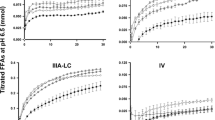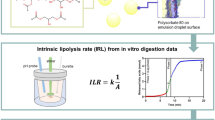Abstract
Lipase-catalyzed hydrolysis of fatty acid esters of 3-hydroxymethyl phenytoin was studied in various triglyceride and ethyl oleate emulsions, dispersed in micellar solutions, and suspended in an aqueous buffered solution. Phenytoin release from ethyl oleate emulsions of the prodrugs show apparent first-order kinetics with the pentanoate to nonanoate derivatives and sigmoidal kinetics with the long-chain fatty acid derivatives (stearate and oleate). A transition in the kinetic behavior, between the short- and the long-chain acyl prodrugs, was observed with the decanoate derivative. These observations are accounted for by a proposed kinetic model. Phenytoin release from the solid prodrugs follows zero-order kinetics and is independent of the total amounts of suspended material but directly proportional to the lipase concentration. Lipolysis of the solid suspended prodrugs was dependent on the length of the acyl side chain of the prodrug, with maxima for the pentanoate and the octanoate derivatives. The short-chain derivatives, acetate and propionate, as well as the long-chain prodrug, stearate, showed the slowest lipolysis rate when present as solid dispersions. The zero-order rate is qualitatively correlated with the melting point of the prodrugs. This result might be expected if the melting point is taken as a measure of the cohesivity or packing of the molecules at the surface of a crystal.
Similar content being viewed by others
REFERENCES
V. J. Stella and T. Higuchi (eds.). Prodrugs as Novel Drug Delivery Systems, Am. Chem. Soc., Washington, D.C., 1975.
E. D. Roche (ed.). Design of Biopharmaceutical Properties Through Prodrugs and Analogs, Am. Pharm. Assoc., Washington, D.C., 1977.
K. J. Widder and R. Green (eds). Drug and enzyme targeting. In Methods in Enzymology, Vol. 112, Part A, Academic Press, New York, 1985.
A. A. Sinkula and S. H. Yalkowsky. J. Pharm. Sci. 64:181–210 (1975).
H. Bundgaard (ed.). Design of Prodrugs, Elsevier, New York, 1985.
K. Arnold, N. Gerber, and G. Levy. Can. J. Pharm. Sci. 5:89–92 (1970).
C. M. Martin, M. Rubin, W. E. O'Malley, V. F. Garagusi, and E. McCauley. Pharmacologist 10:167 (1968).
L. Rail. Med. J. Aust. 11:339 (1968).
T. Suzuki, Y. Saitoh, and K. Nishihara. Chem. Pharm. Bull. 18:405–411 (1970).
S. A. Varia and V. J. Stella. J. Pharm. Sci. 73:1080–1087 (1984).
Y. Yamaoka, R. Roberts, and V. J. Stella. J. Pharm. Sci. 72:400–405 (1983).
H. Bundgaard and M. Johansen. Int. J. Pharm. 5:67–77 (1980).
M. Johansen and H. Bundgaard. Arch. Pharm. Chem. Sci. Ed. 7:175–192 (1979).
DPH prodrugs were prepared from 3-hydroxymethylphenytoin and the corresponding carboxylic acid or acid chloride according to Ref. 11.
E. J. Masoro. Annu. Rev. Physiol. 39:301–321 (1977).
J. F. Mead, R. B. Alfin-Slater, D. Howton, and K. G. Popjak. In Lipids, Chemistry, Biochemistry and Nutrition, Plenum Press, New York, 1986, Chap. 12, pp. 255–272.
A. B. R. Thomson and J. M. Dietschy. In L. R. Johnson (ed.), Physiology of the Gastrointestinal Tract, Raven Press, New York, 1981, Chap. 46, pp. 1147–1220.
Solubilities in micellar solutions were one to three orders of magnitude higher. (unpublished results). See also Refs. 19–22.
T. R. Bates, M. Gibaldi, and J. Kanig. J. Pharm. Sci. 55:191–199 (1966).
T. R. Bates, M. Gibaldi, and J. Kanig. J. Pharm. Sci. 55:901–906 (1966).
A. T. M. Serajuddin, M. Rosoff, and A. H. Goldberg. Pharm. Res. 2:221–224 (1985).
R. Venkataramanan, H. D. Perez, T. Schwinghammer, G. J. Burckart, R. J. Ptachcinski, D. H. Van Thiel, and T. E. Starzl. Res. Comm. Chem. Pathol. Pharm. 53:137–140 (1986).
H. Brokerhoff and R. G. Jensen. In Lipolytic Enzymes, Academic Press, New York, 1974.
R. Verger. In B. Borgström and H. L. Brockman (eds.), Lipase, Elsevier, New York, 1984, Chap. 7.
R. Verger. In D. L. Purich (ed.), Methods in Enzymology, Academic Press, New York, 1980, Vol. 64, pp. 340–392.
D. Quinn, K. Shirai, and R. Jackson. Prog. Lipid Res. 22:35–78 (1982).
K. Kakemi, H. Sezaki, S. Muranishi, H. Ogata, and S. Isemura. Chem. Pharm. Bull. 20:708–714, 715–720 (1972).
T. Noguchi, K. Taniguchi, S. Muranishi, and H. Sezaki. Chem. Pharm. Bull. 25:434–440 (1977).
N. A. Armstrong and K. C. James. Int. J. Pharm. 6:185–193, 195–204 (1980).
H. Sasaki, Y. Takakura, M. Hashida, M. Kimura, and H. Sezaki. J. Pharm. Dyn. 7:120–130 (1984).
H. Nakahara, S. Okada, and K. Mochida. Chem. Pharm. Bull. 30:2673–2681 (1982).
H. Nakahara, S. Okada, K. Mochida, H. Ohmuri, and M. Masui. Chem. Pharm. Bull. 31:4213–4219 (1983).
H. Nakahara, S. Okada, H. Ohmori, and M. Masui. Chem. Pharm. Bull. 32:3803–3811 (1984).
D. Lairon, G. Nalbone, H. Lafont, N. Domingo, and J. C. Hauton. Lipids 13:211–216 (1977).
D. Lairon, G. Nalbone, H. Lafont, J. Leonardi, N. Domingo, J. C. Hauton, and R. Verger. Biochemistry 17:5263–5269 (1978).
Unpublished results from this laboratory.
A. J. Glazko, W. A. Dill, A. Kazenko, L. M. Wolf, and H. E. Carnes. Antibiot. Chemother. 8:516–527 (1958).
A. Kelbaek and K. Ulrich. Arch. Pharm. Chem. 76:1089 (1969).
H. Andersgaard, P. Finholt, R. Gjermundsen, and T. Hoyland. Acta Pharm. Suec. 11:239–248 (1974).
C. T. Bauguess, F. Sadik, J. Fincher, and C. W. Hartman. J. Pharm. Sci. 64:117–120 (1975).
R. J. Kaliszan. J. Pharm. Sci. 75:187–189 (1986).
Unpublished results from this laboratory.
Author information
Authors and Affiliations
Rights and permissions
About this article
Cite this article
Alvarez, F.J., Stella, V.J. Pancreatic Lipase-Catalyzed Hydrolysis of Esters of Hydroxymethyl Phenytoin Dissolved in Various Metabolizable Vehicles, Dispersed in Micellar Systems, and in Aqueous Suspensions. Pharm Res 6, 555–563 (1989). https://doi.org/10.1023/A:1015993112678
Issue Date:
DOI: https://doi.org/10.1023/A:1015993112678




